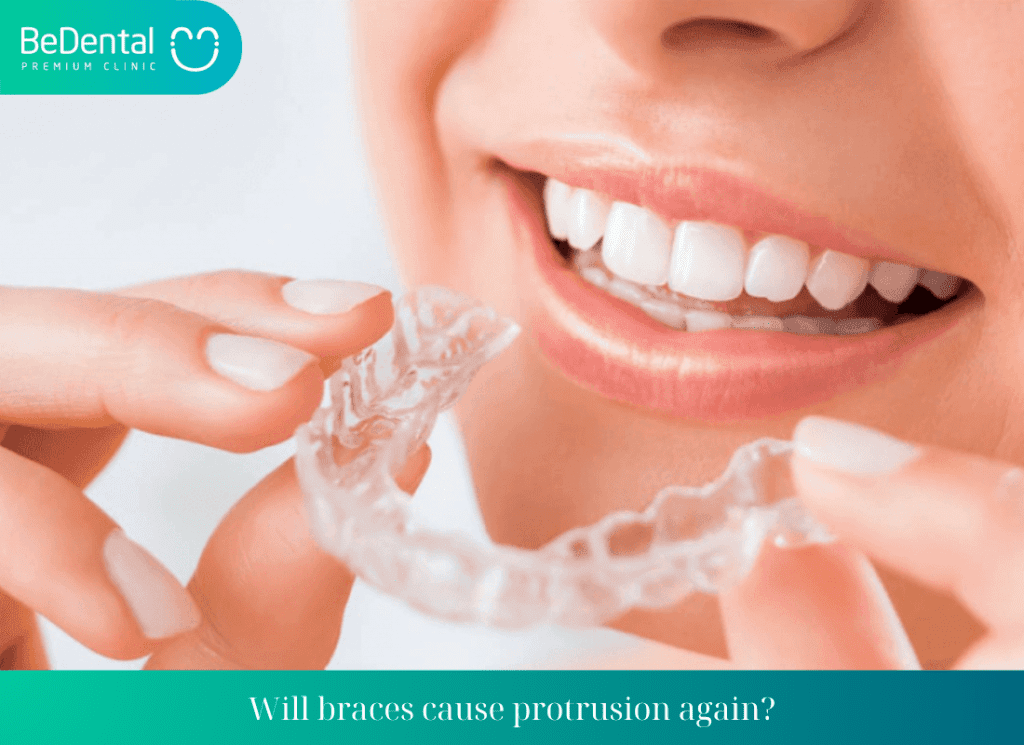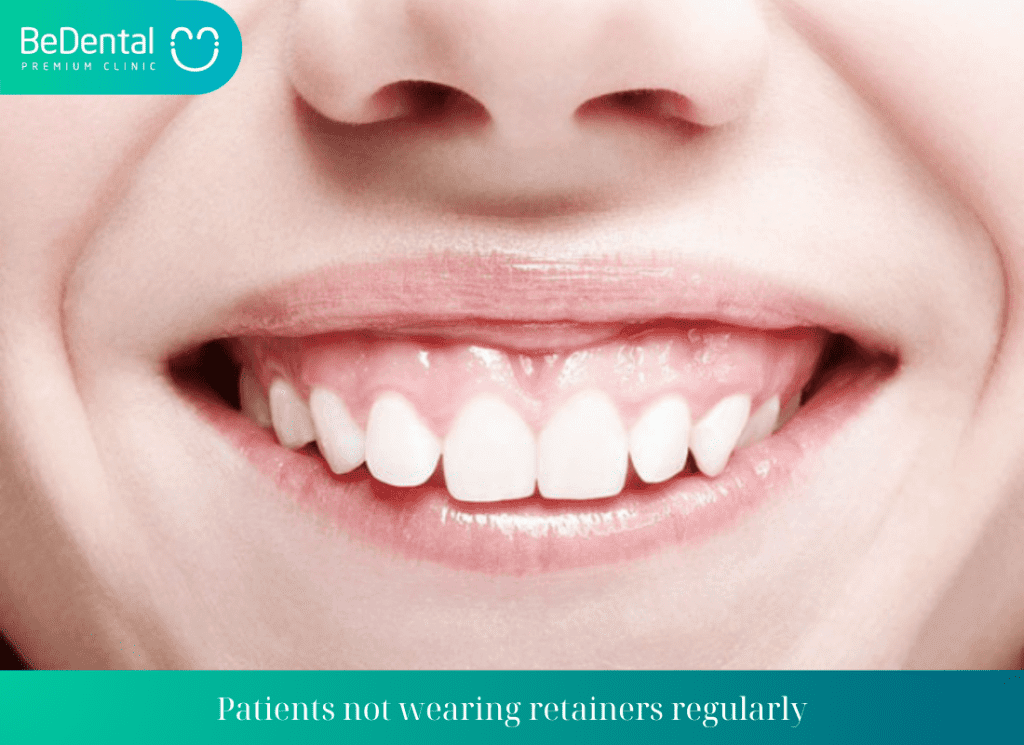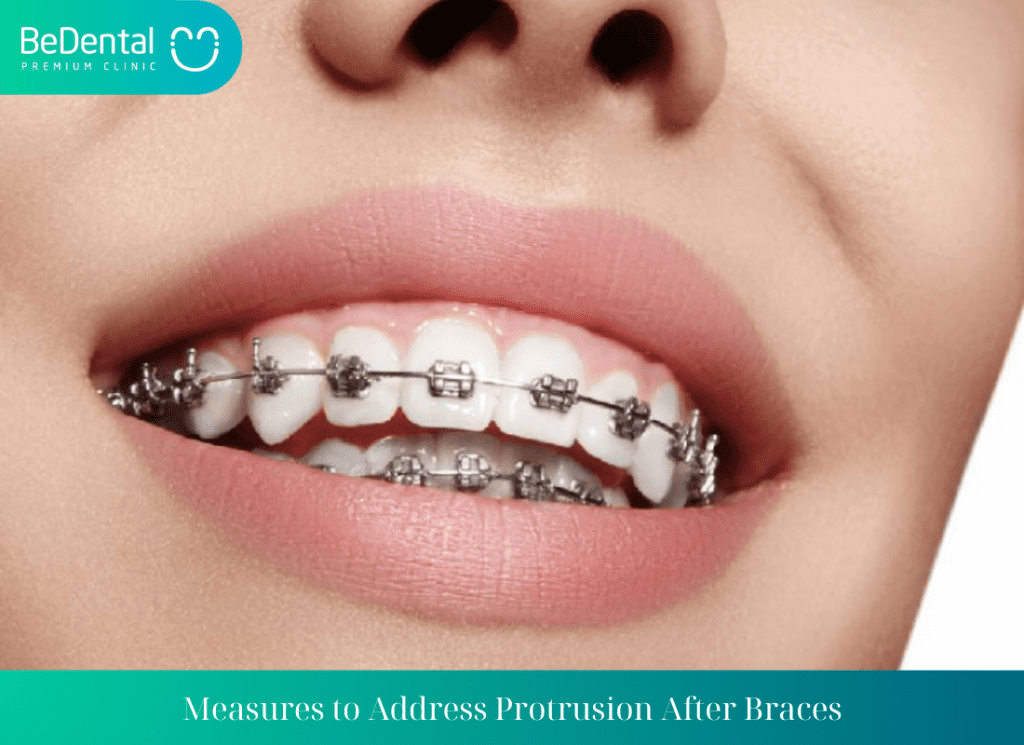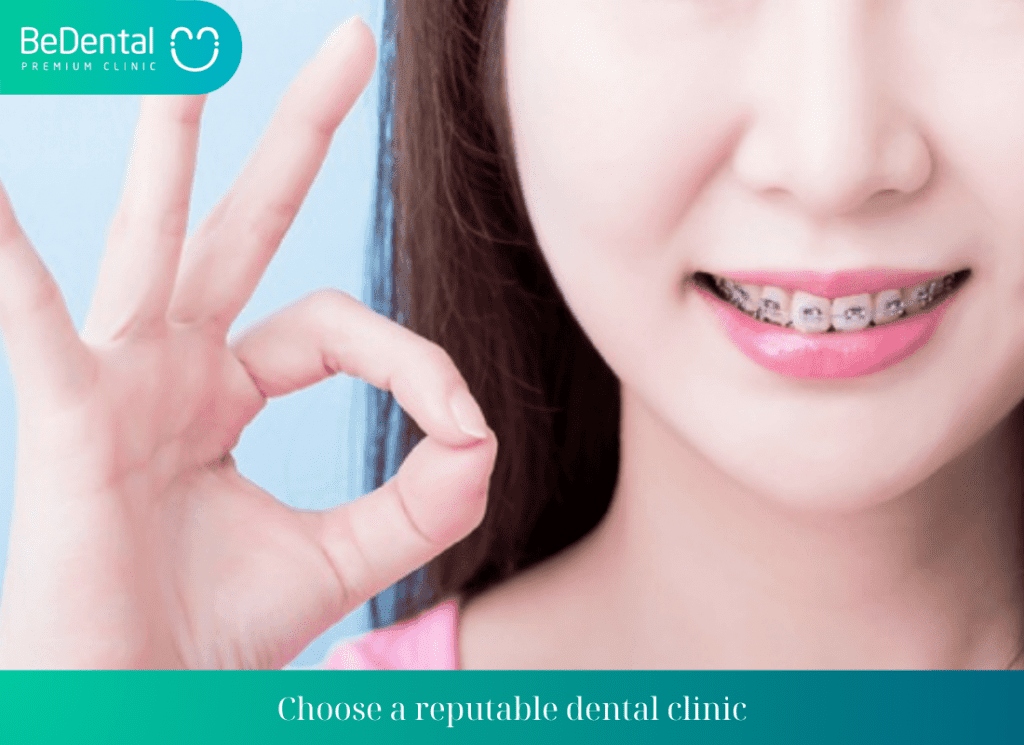Will Braces Cause Protrusion? How to Prevent Teeth Protrusion After Braces? These are common questions that many young people ask after undergoing orthodontic treatment. It’s also a common concern for many young people today. How to minimize the chances of teeth protruding after braces and what measures should be taken to prevent this issue, the following information will help you understand better.
Will braces cause protrusion again?
Will braces cause protrusion again? Braces are a dental treatment method that uses special tools to adjust the position of misaligned teeth in the dental arch. This can improve many dental issues, helping to create harmonious teeth and a balanced face

Will Braces Cause Protrusion? The answer is yes. Many people have experienced teeth protrusion after braces, which affects the aesthetics. This usually happens due to factors such as improper orthodontic techniques due to the dentist’s lack of experience, incorrect oral care, or misjudgment of the initial condition of the teeth.
See more: Bone resorption when wearing braces
Causes of Protrusion After Braces
Patients not wearing retainers regularly
Retainers are one of the important tools that dentists provide to patients after removing braces to maintain the position of the teeth for the longest time possible. During the teeth adjustment process, retainers are used to stabilize the teeth, preventing them from shifting inward, outward, or closer together or further apart.
If the period of wearing retainers after braces is too short, your teeth can easily return to their original position before braces. In cases of protrusion, the likelihood of teeth protruding again due to insufficient retainer wear is high.

Post-Braces Diet Not Following Dentist’s Advice
Dentists always emphasize maintaining the stability of the teeth for 3-6 months before removing braces. However, after removing braces, the teeth are not yet fully stabilized, and the bone surrounding the teeth needs time to recover and keep the teeth firmly in their new positions.
Therefore, if someone who has had braces does not eat soft foods during the period after removing the braces, the risk of teeth protruding is quite high. According to dentists, foods like soup, porridge, rice, and sandwiches should be prioritized after braces removal.
Patients should also avoid chewy, hard, and crispy foods such as crusty bread, roasted veal, tendons, and similar foods.
See more: Things to know when wearing braces
Inadequate Oral Hygiene
Oral hygiene is extremely important both during and after orthodontic treatment. If oral care is not thorough, plaque can form, leading to cavities, gum inflammation, and periodontal disease.
Many people become complacent after removing braces and fail to visit the dentist for regular check-ups, which can make the teeth more prone to periodontal disease and movement.
This is one of the common causes of teeth protrusion after braces. Additionally, habits such as pushing the tongue or sleeping with the mouth open can also contribute to teeth protrusion after braces.

Incorrect Braces Method
Currently, some dentists use incorrect orthodontic methods, leading to less-than-desirable results for patients even after braces are removed.
Specifically, improper application of force during braces treatment, incorrect bracket placement, and inaccuracies in moving the teeth can be among the causes of teeth protrusion recurrence after braces or the development of protrusion after treatment.
See more: Braces or Ceramic Veneers: Pros and cons
Incorrect Assessment of Teeth Condition Before Braces
Braces are effective only for protruding teeth, while correcting jaw protrusion usually requires surgical intervention. Therefore, if the dentist incorrectly assesses the patient’s condition, it is entirely possible for the teeth to protrude after braces.
Removing Braces Too Early
Many patients decide to remove braces before completing the full treatment time as prescribed by the dentist. In such cases, the teeth may not be fully adjusted, leading to the possibility of misalignment, protrusion, and potential facial distortion due to improper occlusion.
Measures to Address Braces Cause Protrusion
When patients notice signs of braces cause protrusion, it is crucial for them to return to the dental clinic that performed the treatment for a timely examination and solution. If patients do not trust the previous dental clinic, they may seek a new one with better quality and highly skilled professionals

After removing braces, if within 1 to 6 months you notice that your teeth are shifting and your front teeth are slightly protruding due to instability in the jawbone, the remedy is usually simpler, such as wearing a retainer to improve the condition.
However, if braces cause protrusion more than 1 year after braces removal, wearing a retainer is often less effective. In this case, patients may need to undergo a second round of braces treatment to address the protrusion.
See more: What Is the Appropriate Age for Braces?
For protrusion caused by the jawbone, a complete correction usually requires surgical intervention to cut and reposition the bone, balancing the upper and lower jaws. This will significantly improve protrusion and create a more harmonious facial appearance.
What to Do if Teeth Protrude Again After Braces?
The recurrence of teeth protrusion after braces can cause concern, as there is a high risk of needing another round of braces. According to experienced orthodontists, this situation can be categorized as follows:
- Teeth protrude within 6 months after braces: This is a mild protrusion where the bone surrounding the teeth is still stabilizing and the teeth may still be slightly loose. In this case, intervention with a retainer or adjusting the retainer to apply more pressure to reposition the teeth might be effective.
- Teeth protrude more than 1 year after braces: At this point, the teeth have stabilized in the bone, and moving the teeth to the desired position with braces might be less effective. In this case, patients should consult a reputable dentist for advice on a better orthodontic method and follow the recommended treatment plan.
Consider Treatment Options
- For Protrusion Within 6 Months: If the protrusion is mild and occurred within the first 6 months, your orthodontist might recommend adjusting your retainer or increasing wear time to correct the issue.
- For Protrusion After 1 Year: If the protrusion occurs more than a year after treatment, it may require a more comprehensive approach. Your orthodontist might suggest a new round of braces or other orthodontic treatments to address the issue.
Assess Underlying Causes
Determine if the protrusion is due to jawbone issues or other underlying problems. For jaw-related issues, surgical intervention might be necessary to correct the alignment of the jaw.
How to Prevent Braces Cause Protrusion?
To prevent braces cause protrusion, patients should consider the following important points:
See more: What is Orthodontic archwire?
Choose a reputable dental clinic
To avoid complications during and after braces treatment, patients should carefully research and choose a reputable and high-quality dental clinic. A reputable clinic typically has the following features:
- Highly skilled and experienced dental professionals
- Modern equipment and technology
- Positive reviews and feedback from previous patients
- Detailed examination and consultation
Regularly wear retainers to avoid braces cause protrusion

To prevent teeth from moving back to their original positions, it is crucial to adhere to wearing retainers after braces. Typically, the retainer wear period lasts from 6 to 12 months. During the first 6 months, patients need to wear the retainer continuously, for at least 22 hours each day, removing it only for eating and oral hygiene. After this period, following the dentist’s instructions, patients can gradually reduce the retainer wear time.
Adhering to the retainer schedule will help ensure that the teeth maintain their positions after the braces treatment. Failing to wear the retainer for the prescribed time or not following the schedule can lead to the teeth returning to their original positions, negating the results achieved from the braces treatment.
See more: Signs of gum recession during braces
Proper Oral Care
To maintain oral health after removing braces, establishing a good oral care and healthy eating routine is essential. Here are some key points to consider:
- Diet
- Oral hygiene
- Use of dental floss
These measures will help protect oral health after braces. We hope this information is useful and helps you maintain healthy teeth after completing braces treatment.
Conclusion
In conclusion, while braces can effectively correct teeth alignment, it’s essential to follow up with proper care to prevent recurrence of issues like teeth protrusion. Adhering to a rigorous retainer schedule is crucial for maintaining the results achieved during orthodontic treatment. Typically, wearing retainers for 6 to 12 months, with continuous wear in the initial phase, helps stabilize the teeth in their new positions.
Additionally, maintaining good oral hygiene and a healthy diet, along with regular dental check-ups, plays a significant role in preserving the outcomes of orthodontic work. If teeth protrusion does occur after braces, it’s important to consult with a reputable orthodontist for timely evaluation and treatment.
The above article has helped you answer the question: “Will Braces Cause Protrusion?”. Contact Bedental if you want advice on appropriate methods to have more precious information, we will provide free help 24/7.
Tư vấn chuyên môn bài viết:
BÁC SĨ DƯƠNG THỊ THÙY NGA





